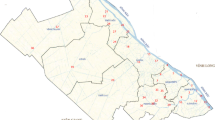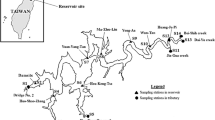Abstract
Multivariate statistical techniques such as cluster analysis (CA), principal component analysis (PCA), factor analysis (FA), and discriminant analysis (DA) were applied for the assessment of spatial and temporal variations of a large complex water quality data set of the Nampong River and Songkhram River, generated for more than 10 years (1996–2012) by monitoring of 16 parameters at different sites. According to the water quality characteristics, hierarchical CA grouped 13 sampling sites of the Nampong River into two clusters, i.e., upper stream (US) and lower stream (LS) sites, and five sampling sites of the Songkhram River into three clusters, i.e., upper stream (US), middle stream (MS) and lower stream (LS) sites. PCA/FA applied to the data sets thus obtained five latent factors explaining 69.80 and 69.32 % of the total variance in water quality data sets of LS and US areas, respectively, in the Nampong River and six latent factors explaining 80.80, 73.95, and 73.78 % of the total variance in water quality data sets of LS, MS, and US areas, respectively, in the Songkhram River. This study highlights the usefulness of multivariate statistical assessment of complex databases in the identification of pollution sources to better comprehend the spatial and temporal variations for effective river water quality management.


Similar content being viewed by others
References
Abdul-Wahab, S. A., Bakheit, C. S., & Al-Alawi, S. M. (2005). Principal component and multiple regression analysis in modelling of ground-level ozone and factors affecting its concentrations. Environmental Modelling & Software, 20(10), 1263–1271.
Alexakis, D. (2011). Assessment of water quality in the Messolonghi–Etoliko and Neochorio region (West Greece) using hydrochemical and statistical analysis methods. Environmental Monitoring and Assessment, 182(1-4), 397–413.
Blake, D., & Pitakthepsombut, R. (2006a). Situation analysis: lower Songkhram river basin, Thailand: a publication of the Mekong Wetlands biodiversity conservation and sustainable use programme.
Batayneh, A., & Zumlot, T. (2012). Multivariate statistical approach to geochemical methods in water quality factor identification; application to the shallow aquifer system of the Yarmouk basin of north Jordan. Research Journal of Environmental and Earth Sciences, 4(7), 756–768.
Blake, D. & Pitakthepsombut, R. (2006b). Situation analysis: lower Songkhram river basin, Thailand: a publication of the Mekong wetlands biodiversity conservation and sustainable use programme.
Boyacioglu, H., & Boyacioglu, H. (2007). Water pollution sources assessment by multivariate statistical methods in the Tahtali basin, Turkey. Environmental Geology, 54, 275–282.
Coletti, C., Testezlaf, R., Ribeiro, T. A. P., Souza, R. T. G., & Pereira, D. A. (2010). Water quality index using multivariate factorial analysis. Revista Brasileira de Engenharia Agrícola e Ambiental, 14, 517–522.
Hair, J. E., William, C. B., Barry, J. B., Rolph, E. A., & Tatham, R. L. (2006). Multivariate data analysis (6 ed., ). New Jersy:Pearson Printice Hall.
Helena, B., Pardo, R., Vega M., Barrado, E., Fernandez, J.M., & Fernandez, L. (2000). Temporal evolution of groundwater composition in an alluvial aquifer (Pisuerga river, Spain) by principal component analysis. Water Research, 34, 807-816.
Guangjia, J., Dianwei, L., Kaishan, S., Zongming, W., Bai, Z., & Yuandong, W. (2010). Application of multivariate model based on three simulated sensors for water quality variables estimation in Shitoukoumen reservoir, Jilin province, China. Chinese Geographical Science, 20(4), 337–344.
Kim, J.-O., & Mueller, C. W. (1987). Introduction to factor analysis: what it is and how to do it. Quantitative applications in the social sciences series. Newbury Park:Sage University Press.
Liu, C. W., Lin, K. H., & Kuo, Y. M. (2003). Application of factor analysis in the assessment of groundwater quality in a Blackfoot disease area in Taiwan. Science in the Total Environment, 313, 77–89.
Love, D., Hallbauer, D., Amos, A., & Hranova, R. (2004). Factor analysis as a tool in groundwater quality management: two southern African case studies. Physics and Chemistry of the Earth, 29, 1135–1143.
McKenna Jr., J. E. (2003). An enhanced cluster analysis program with bootstrap significance testing for ecological community analysis. Environmental Modelling & Software, 18(3), 205–220.
Muangthong, S. (2015). Assessment of surface water quality using multivariate statistical techniques: a case study of the Nampong river basin, Thailand. The Journal of Industrial Technology, 11(1), 25–37.
Reghunath, R., Murthy, T. R. S., & Raghavan, B. R. (2002). The utility of multivariate statistical techniques in hydrogeochemical studies: an example from Karnataka, India. Water Research, 36, 2437–2442.
Sarbu, C., & Pop, H. F. (2005). Principal component analysis versus fuzzy principal component analysis. A case study: the quality of Danube water (1985–1996). Talanta, 65, 1215–1220.
Shihab, A. S., & Abdul Baqi, Y. T. (2010a). Multivariate analysis of ground water quality of Makhmor plain/north Iraq. Damascus University Journal, 26(1), 19–26.
Simeonov, V., Stratis, J. A., Samara, C., Zachariadis, G., Voutsa, D., Anthemidis, A., & Sofoniou, M. (2003). Assessment of the surface water quality in northern Greece. Water Research, 37, 4119–4124.
Singh, K. P., Amrita, M., Dinesh, M., & Sarita, S. (2004). Multivariate statistical techniques for the evaluation of spatial and temporal variations in water quality of Gomti river (India) a case study. Water Research, 38, 3980–3992.
Singh, K. P., Malik, A., & Sinha, S. (2005). Water quality assessment and apportionment of pollution sources of Gomti river (India) using multivariate statistical techniques: a case study. Analytica Chimica Acta, 538, 355–374.
Shrestha, S., & Kazama, F. (2007). Assessment of surface water quality using multivariate statistical techniques: a case study of the Fuji river basin, Japan. Environmental Modelling & Software, 22, 464–475.
Shrestha, S., Kazama, F., & Nakamura, T. (2008). Use of principal component analysis, factor analysis and discriminant analysis to evaluate spatial and temporal variations in water quality of the Mekong river. Journal of Hydroinformatics, 10, 43–54.
Shrestha, S., & Muangthong, S. (2014). Assessment of surface water quality of Songkhram river (Thailand) using environmettric techniques. International Journal of River Basin Management, 12(4), 341–356.
Sombutputorn N. (1998). An application of remotely sensed data and geographic information system for wetland ecosystem mapping. Master thesis of Korn Kaen University.
Zhang, X., Wang, Q., Liu, Y., Wu, J., & Yu, M. (2011). Application of multivariate statistical techniques in the assessment of water quality in the southwest new territories and Kowloon, Hong Kong. Environmental Monitoring and Assessment, 173(1–4), 17–27.
Zhou, F., Liu, Y., & Guo, H. C. (2007). Application of multivariate statistical methods to the water quality assessment of the watercourses in the northwestern new territories, Hong Kong. Environmental Monitoring and Assessment, 132(1–3), 1–13.
Acknowledgments
The authors wish to thank Faculty of Engineering and Architecture, Rajamangala University of Technology Isan for providing financial assistance. The authors also sincerely thank Pollution Control Department (PCD), Thailand, for providing river water quality monitoring data.
Author information
Authors and Affiliations
Corresponding author
Rights and permissions
About this article
Cite this article
Muangthong, S., Shrestha, S. Assessment of surface water quality using multivariate statistical techniques: case study of the Nampong River and Songkhram River, Thailand. Environ Monit Assess 187, 548 (2015). https://doi.org/10.1007/s10661-015-4774-1
Received:
Accepted:
Published:
DOI: https://doi.org/10.1007/s10661-015-4774-1




